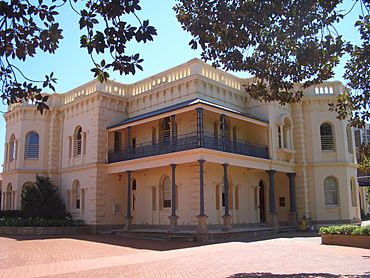Edgecliff, New South Wales facts for kids
Quick facts for kids EdgecliffSydney, New South Wales |
|||||||||||||||
|---|---|---|---|---|---|---|---|---|---|---|---|---|---|---|---|

Ascham School, Edgecliff.
|
|||||||||||||||
| Postcode(s) | 2027 | ||||||||||||||
| Elevation | 39 m (128 ft) | ||||||||||||||
| Area | 0.32 km2 (0.1 sq mi) | ||||||||||||||
| Location | 4 km (2 mi) E of Sydney CBD | ||||||||||||||
| LGA(s) | Municipality of Woollahra | ||||||||||||||
| State electorate(s) |
|
||||||||||||||
| Federal Division(s) | Wentworth | ||||||||||||||
|
|||||||||||||||
Edgecliff is a small suburb located in the Eastern Suburbs of Sydney, New South Wales, Australia. It is about 4 kilometres east of the main city centre of Sydney. Edgecliff is part of the Municipality of Woollahra. Its postcode is 2027.
Edgecliff is surrounded by other suburbs like Double Bay, Woollahra, Paddington, Rushcutters Bay and Darling Point. Many homes in Edgecliff have amazing views of Port Jackson (Sydney Harbour). Because it is so close to the city and the harbour, homes here can be quite expensive.
Contents
Discovering Edgecliff's Past
Edgecliff gets its name from its location. It sits on a rocky cliff. In the early days of European settlement, people dug up a lot of rock from this cliff.
Historic Buildings and Estates
For a long time, a large property called Glenrock dominated the area. It was on the north side of New South Head Road. In 1864, Sir Edward Knox built a grand house called Fiona. It was designed by J. F. Hilly and was a beautiful two-storey mansion made of sandstone.
Another important building on the estate was Glenrock. This house was designed by David MacBeath around 1870. The estate also had impressive gates made of wrought iron and sandstone. These gates are still around today, even though the Glenrock building was taken down when the road was made wider.
The Dower House was also part of the estate. It was a sandstone house built after 1842. Today, the Glenrock property is where Ascham School is located. Many of these historic items are protected as part of Australia's National Estate.
Trams and Trains in Edgecliff
In September 1894, a special cable tram service started in Edgecliff. It ran from King Street in the city to Ocean Street in Edgecliff. Unlike other trams that used steam, this tram was pulled by a moving cable hidden in a gutter between the tracks. The tram cars would grip the cable to move and let go to stop. This cable tram ran until 1905, when the tram line was changed to use electricity.
Later, in 1979, the Edgecliff railway station opened. This happened when the Eastern Suburbs railway line was completed. This new train line connected Central Station to Bondi Junction.
Edgecliff's Heritage Sites
Edgecliff has some places that are listed for their historical importance. One of these is:
- 8 Albert Street: Fenton and surrounds
Who Lives in Edgecliff?
The 2016 census showed that 2,580 people lived in Edgecliff. Most people had Anglo-Celtic backgrounds, with many having English, Australian, Irish, or Scottish ancestry. About 53.3% of people were born in Australia, and 7.4% were born in England. Most people (72.6%) spoke only English at home.
When it came to religion, the most common answers were No Religion (33.0%) and Catholic (19.1%). Because Edgecliff has a train station and is close to the city, many people use public transport. About 41.8% of people travelled to work by public transport. This is much higher than the national average of 10.4%.
Most homes in Edgecliff are apartments (73.6%). The rest are mostly semi-detached houses (21.6%). In the 2021 census, the population of Edgecliff was 2,499.
Shopping and Businesses
You can find many shops and businesses along New South Head Road. The Edgecliff Centre is a building with shops on the lower levels and offices above. It is very close to the train station and bus services.
Edgecliff Eastpoint is a shopping centre located right above Edgecliff railway station. It is also below the bus interchange, making it easy for people to get to.
Getting Around Edgecliff
Edgecliff railway station is an underground train station. It is part of the Sydney Trains network's Eastern Suburbs Line. During busy times, trains arrive every 3 to 5 minutes. During quieter times, trains come every 8–10 minutes. There is also a large bus interchange located right above the train station, making it easy to switch between trains and buses.
Schools in the Area
Edgecliff is home to some well-known schools. Ascham School is a girls' school located here. One of Sydney Grammar's preparatory schools is also on the borders of Edgecliff. The Weigall Sports Field and White City, which are used by Sydney Grammar School, are also nearby.
Sports and Fun
Since 1908, Edgecliff has been represented in the National Rugby League, which is a very popular sport in Australia. The local team is the Sydney Roosters, also known as the Eastern Suburbs District Rugby League Football Club.








